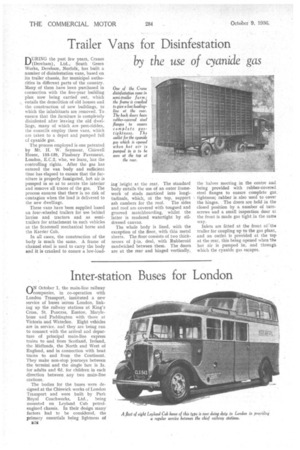Inter-station Buses for London
Page 50

Page 51

If you've noticed an error in this article please click here to report it so we can fix it.
(IN October 1, the main-line railway 14,-, companies, in co-operation with London Transport, instituted a new service of buses across London, linking up the railway stations at King's Cross, St. Pancras, Euston, Marylebone and Paddington with those at Victoria and Waterloo. Eight vehicles are in service, and they are being run to connect with the arrival and departure of principal main-line express trains to .and from Scotland, Ireland, the Midlands, the North and West of England, and in connection with boat trains to and from the Continent. They make non-stop journeys between the termini and the single fare is 1s. for adults and (Id, for children in each direction between any two math-line stations, The bodies for the buses were designed at the Chiswick works of London Transport and were built by Park Royal Coachworks, Ltd„ being mounted on Leyland Cub petrolengined chassis. In their design many factors had to be considered, the primary essentials being lightness of
Weight, comfort, pleasing . appearance and suitability for . negotiating tha principal. main-line ,stations. The bodies are of all-metal constnic: tion and seat 20 passengers.' 12 of them being accommodated in an observation saloon at the ± ear. The seats are built up on tubular metal frames and have Dunlopillo cushions. The metal tubing, is of MG7 alloy,, which was chosen because of its non-corrosive qualities.
As the vehicles are. required for transferring passengers with their luggage, it was essential to provide the maximum space for baggage. Because of this fact, it was deemed desirable to make a departure from the stereotype method of accommodating luggage on the roof, and to adopt an observation type of bus which would house one ton of passengers' effects beneath the observation saloon: This policy has been successfully interpreted in the design of the new type of vehicle without any loss of symmetry and without destroying the general good balance. Access to the luggage compartment is through two large doors at the rear and by a small door at each side. The provision of these doors permits quick and easy loading and unloading. This section is devoid of corners, which might damage passengers' personal effects, and the interior :is illuminated by three lamps which are arranged so that they are automatically switched off when the doors are closed.
A sliding door, centrally disposed on the near side. gives access to the passenger saloons, the observation section being reached by three steps leading up from the forward compartment. There is also a swing door on the off side of the body.
Careful consideration has been given to the interior finish so as to provide, wherever possible, rounded corners and
blended lines, which not only facilitate cleaning, but give a pleasing appearance. A special interior window finisher has been used, so that all -corners are radiused. The interior lining panels, window finishers and roof panels are covered with Rexine.
The driver is provided with an adjustable seat, and three mirrors are fitted at the front to give good vision at both sides and of the interior. A quick-acting signalling window enables the driver to signal to other traffic.




























































































